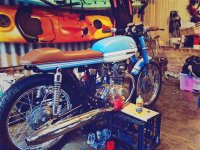Tunnelvision111
New Member
The bike starts and idles just fine, however as soon as my fat ass sits on it, slaps it into 1st, and hits the gas it starts bucking, hesitating, and surging. In the garage it will not rev smoothly >2000RPM, and won’t go over 5000RPM anymore.
This is a brand new rebuild from the ground up. New Pistons, rings, hone, valves & seats lapped. It ran fine for a week. Then one day on the way home it started coughing, sputtering, and surging.
I’ve checked the following three times now:
1. Points: checked and adjusted
2. Timing: Checked and adjusted
3. Tappets: Checked and adjusted
4. Spark advance: Checked, not binding, its operational
5. Carburettors: Cleaned, checked and adjusted
a. Went all the way up and all the way down on the needle one increment at a time
b. Tried all three main jet sizes (90, 100, 105’s) whilst keeping the needle in the centre position
6. Battery: its good.
7. Compression: will check again but measured 155-160psi across both cylinders after I first fired it up.
8. Running a tad rich, but no cause for concern. Will run the same thing on fresh plugs.
9. Checked for an air leak - sprayed start ya bastard around both carbs, no change in RPM
What’s next on my list……
1. Check the torque on the head bolts
3. Put a scope in the cylinders to check visually for damage
4. Try the old condenser again, acquire a new one if available. The accel 140403s coil I installed was throwing a pretty fat spark, Perhaps it cooked the condenser? I’ve noticed an orange/yellow spark on the points recently….I recall it being a nice fat blue before.
5. Perform compression tests again.
a. If poor, I guess I’ll check for leaks and adjust the tappets one more time. After that, I’m going to tear the engine down.
b. If the compression is decent…..well I don’t know.
Can anyone shed some light on this situation. I'm at a loss and really really don't want to have to tear the engine down. It dosent smoke or backfire. Just a whaaaa......whaaaa....um....whaaaa when I try and ride it.
This is a brand new rebuild from the ground up. New Pistons, rings, hone, valves & seats lapped. It ran fine for a week. Then one day on the way home it started coughing, sputtering, and surging.
I’ve checked the following three times now:
1. Points: checked and adjusted
2. Timing: Checked and adjusted
3. Tappets: Checked and adjusted
4. Spark advance: Checked, not binding, its operational
5. Carburettors: Cleaned, checked and adjusted
a. Went all the way up and all the way down on the needle one increment at a time
b. Tried all three main jet sizes (90, 100, 105’s) whilst keeping the needle in the centre position
6. Battery: its good.
7. Compression: will check again but measured 155-160psi across both cylinders after I first fired it up.
8. Running a tad rich, but no cause for concern. Will run the same thing on fresh plugs.
9. Checked for an air leak - sprayed start ya bastard around both carbs, no change in RPM
What’s next on my list……
1. Check the torque on the head bolts
3. Put a scope in the cylinders to check visually for damage
4. Try the old condenser again, acquire a new one if available. The accel 140403s coil I installed was throwing a pretty fat spark, Perhaps it cooked the condenser? I’ve noticed an orange/yellow spark on the points recently….I recall it being a nice fat blue before.
5. Perform compression tests again.
a. If poor, I guess I’ll check for leaks and adjust the tappets one more time. After that, I’m going to tear the engine down.
b. If the compression is decent…..well I don’t know.
Can anyone shed some light on this situation. I'm at a loss and really really don't want to have to tear the engine down. It dosent smoke or backfire. Just a whaaaa......whaaaa....um....whaaaa when I try and ride it.





